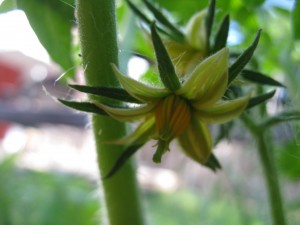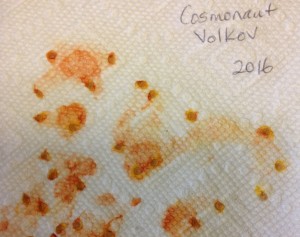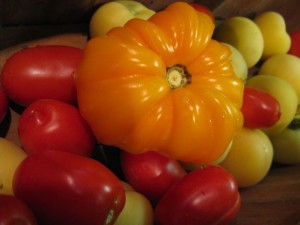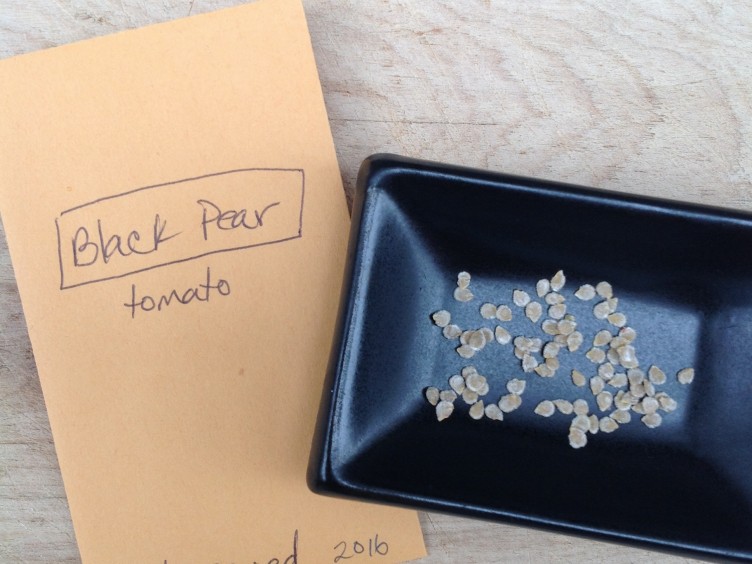One of the amazing things about heirloom tomatoes is their incredible taste and wide variety of colours, sizes and shapes. Another amazing thing is that you can save the seeds to grow your favourites again and again in the years to come. Not only will this save you money, but it will also keep you from being disappointed if your seed supplier stops carrying your most treasured variety.
When saving seeds, it is important to choose a variety that is marked as either heirloom or open pollenated. This means that the next generation of plants will be the same as the current generation. Although you can save seeds from hybrid plants, you do not know what kind of tomatoes will grow from these seeds – you may be lucky and get the same thing, or you may get a plant with completely different characteristics.
 Tomatoes are self-pollenating, meaning the flowers contain both male and female parts, and so a single flower is able to produce fruit with viable seeds. Because of this, tomatoes do not often cross-pollenate, making it easy to save seeds that grow true.
Tomatoes are self-pollenating, meaning the flowers contain both male and female parts, and so a single flower is able to produce fruit with viable seeds. Because of this, tomatoes do not often cross-pollenate, making it easy to save seeds that grow true.
Whichever variety you choose, you should select tomatoes that are healthy and ripe. Ideally you should collect seeds from multiple tomatoes grown on multiple plants. If space permits, the variety to be saved should be at least 20 feet away from other varieties of tomatoes. But who has that kind of room in their urban garden?
Tomato seeds are coated with a jelly-like substance that contains germination inhibitors. This is a good thing, because without it, the seeds would germinate inside the ripe fruit. It does, however, make it more difficult when you actually want germination. There are two approaches to this problem: be patient, or try to remove the jelly.
 If you decide to just be patient, congratulations, you are a better person than me! In this case, spread the seeds out on a paper towel and wait for them to dry (it should take a couple of days). It’s not pretty, but it does the job. Label the paper with the tomato type and year, and store in an envelope. When it is time to grow the tomato plants, peel the seeds off the paper towel and plant as usual. Because of the inhibitors, germination will take a few days longer than usual.
If you decide to just be patient, congratulations, you are a better person than me! In this case, spread the seeds out on a paper towel and wait for them to dry (it should take a couple of days). It’s not pretty, but it does the job. Label the paper with the tomato type and year, and store in an envelope. When it is time to grow the tomato plants, peel the seeds off the paper towel and plant as usual. Because of the inhibitors, germination will take a few days longer than usual.
If you are like me, and think 3 extra days until germination is just too long, you can remove the jelly through fermentation. Scrape the seeds into a container, and fill the container with water. The seeds will sink. Cover, and let sit. In a few days, you may see tiny bubbles in the surface scum that develops, and the seeds will float. There will also be a fairly unpleasant smell. At this point, drain the seeds from the water, give them a bit of a rinse, and spread them out to dry. You can use a paper towel, but I use a ceramic plate, so I can dislodge the seeds easily once they are dry.
 Once again (I can’t stress this enough), label the seeds! It is easy to forget which variety you are saving, because the procedure takes several days. I prefer to save seeds from different varieties at different times, to reduce confusion.
Once again (I can’t stress this enough), label the seeds! It is easy to forget which variety you are saving, because the procedure takes several days. I prefer to save seeds from different varieties at different times, to reduce confusion.
As with all seeds, store them in a cool and well ventilated location with low humidity. Once dry, tomato seeds will be viable for at least 10 years.

